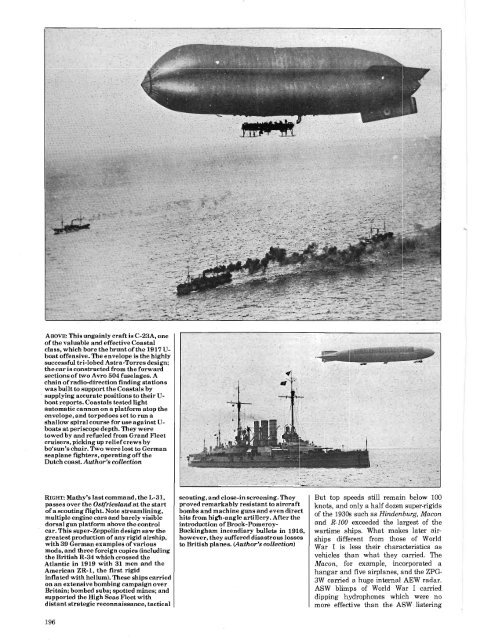Create successful ePaper yourself
Turn your PDF publications into a flip-book with our unique Google optimized e-Paper software.
ABovE: This ungainly craft is C-23A, one<br />
ofthe valuable and effective Coastal<br />
class, which bore the brunt of.the 1917 U-<br />
boat offensive. The envelope is the highly<br />
successful tri-lobed Astra-Torres design;<br />
the car is constructed from the forward<br />
sections of two Ar.ro 5O4 fuselages. A<br />
chain of radio-direction finding stations<br />
was built to supportthe Coastals by<br />
supplying accurate positions to their U-<br />
boat reports. Coastals tested light<br />
automatic cannon on a platform atop the<br />
envelope, and torpedoes set to run a<br />
shallow spiral course for use against U-<br />
boats at periscope depth. They were<br />
towed by and refueled from Grand Fleet<br />
cruisers, picking up reliefcrews by<br />
bo'sun's chair. T\vo wer€ lost to German<br />
seaplane fighters, operating off the<br />
Dutch coast. A uthor's collection<br />
RIGHT: Mathy's last command, the L-31,<br />
passes over the Ostfrieslnnd. at the start<br />
of a scouting flight. Note streamlining,<br />
multiple engine cars and barely visible<br />
dorsal gun platform above the control<br />
car. This super-Z,eppelin design sawthe<br />
greatest production of any rigid airship,<br />
with 39 German examples of various<br />
mods, and three foreign copies (including<br />
the British R-34 which crossed the<br />
Atlantic in 1919 with 31 men and the<br />
American ZR-l, the first rigid<br />
inflated with helium). These ships carried<br />
on an extensive bornbing campaign over<br />
Britain; bombed subs; spotted mines; and<br />
supported the High Seas Fleet with<br />
distant strategic reconnaissance, tactical<br />
196<br />
scouting, and close-in screening. They<br />
proved remarkably resistant to aircraft<br />
bombs and machine guns and even direct<br />
hits from high-angle artillery. Afterthe<br />
introduction of Brock-Pomeroy-<br />
Buckingham incendiary bullets in 1916,<br />
however, they suffered disastrous losses<br />
to British plane s. (Author's colleetion\<br />
But top speeds still remain below 100<br />
knots, and only a halfdozen super-rigids<br />
of the 1930s such as Hind.enburg, Macon<br />
and R-100 exceeded the largest of the<br />
wartime ships. What makes later airships<br />
different from those of World<br />
War I is less their characteristics as<br />
vehicles than what they carried. The<br />
Macon, for example, incorporated a<br />
hangar and five airplanes, and the ZPG-<br />
3W carried a huge internal AEW radar.<br />
ASW blimps of World War I carried<br />
dipping hydrophones which were no<br />
more effective than the ASW listering



